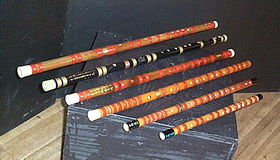Dizi (Ti-tzu, or just Ti) : bamboo flute from China
The characteristic buzz-like or reedy tone of the Dizi is produced by an extra seventh hole which is covered with rice paper. This extra hole is between the mouth hole and the first finger. As the air column passes through the flute it causes the paper to vibrate. Learning to properly place the rice paper with just enough tension is an art unto itself.

Many of these flutes are also works of art as well as fine instruments. Some have poems inscribed near the head joint, others might have jade at both ends. There are also several different lacquer finishes used and often ornate bands wrapped around the diameter along the length of the Dizi. There are also usually vent holes at the far end of the instrument from the mouth hole which are sometimes decorated with colorful strings and tassels.
Unlike western metal flutes there are no lip plates or mechanisms such as keys. Like the Bansuri half steps and micro tones are played by partially covering the appropriate finger hole, but most Dizi players only use 3 or 4 of their fingers to alter pitches, relying on a set of flutes for all the keys as they also come in varying lengths resulting in varying pitch centers and ranges.
The actual sizes in the picture range from 16" to 32 1/2". Except for the largest (which has an added minor third in addition to the major third) the scale is close to a western Major scale with the 7th being slightly lower. They also have a range of slightly more than two octaves.
Hear the Dizi on 'Botswana Waltz' and 'Just Visiting' from 'bamboo dynasty', on 'Dizi Gigue' and ' "Five" ' from 'Svadharma', on 'Rain Forest Cave' from 'Lake Melva Meditation', and on Tracks 1 & 3 from 'Riversticks: The Ferryman's Release'.